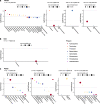Age and sex-associated variation in the multi-site microbiome of an entire social group of free-ranging rhesus macaques
- PMID: 33752735
- PMCID: PMC7986251
- DOI: 10.1186/s40168-021-01009-w
Age and sex-associated variation in the multi-site microbiome of an entire social group of free-ranging rhesus macaques
Abstract
Background: An individual's microbiome changes over the course of its lifetime, especially during infancy, and again in old age. Confounding factors such as diet and healthcare make it difficult to disentangle the interactions between age, health, and microbial changes in humans. Animal models present an excellent opportunity to study age- and sex-linked variation in the microbiome, but captivity is known to influence animal microbial abundance and composition, while studies of free-ranging animals are typically limited to studies of the fecal microbiome using samples collected non-invasively. Here, we analyze a large dataset of oral, rectal, and genital swabs collected from 105 free-ranging rhesus macaques (Macaca mulatta, aged 1 month-26 years), comprising one entire social group, from the island of Cayo Santiago, Puerto Rico. We sequenced 16S V4 rRNA amplicons for all samples.
Results: Infant gut microbial communities had significantly higher relative abundances of Bifidobacterium and Bacteroides and lower abundances of Ruminococcus, Fibrobacter, and Treponema compared to older age groups, consistent with a diet high in milk rather than solid foods. The genital microbiome varied widely between males and females in beta-diversity, taxonomic composition, and predicted functional profiles. Interestingly, only penile, but not vaginal, microbiomes exhibited distinct age-related changes in microbial beta-diversity, taxonomic composition, and predicted functions. Oral microbiome composition was associated with age, and was most distinctive between infants and other age classes.
Conclusions: Across all three body regions, with notable exceptions in the penile microbiome, while infants were distinctly different from other age groups, microbiomes of adults were relatively invariant, even in advanced age. While vaginal microbiomes were exceptionally stable, penile microbiomes were quite variable, especially at the onset of reproductive age. Relative invariance among adults, including elderly individuals, is contrary to findings in humans and mice. We discuss potential explanations for this observation, including that age-related microbiome variation seen in humans may be related to changes in diet and lifestyle. Video abstract.
Keywords: Aging; Genital microbiome; Gut microbiome; Non-human primates; Oral microbiome; Sex differences.
Conflict of interest statement
The authors declare that they have no competing interests.
Figures




Similar articles
-
Yearly variation coupled with social interactions shape the skin microbiome in free-ranging rhesus macaques.Microbiol Spectr. 2023 Sep 26;11(5):e0297423. doi: 10.1128/spectrum.02974-23. Online ahead of print. Microbiol Spectr. 2023. PMID: 37750731 Free PMC article.
-
Taxonomic and Functional Compositions of the Small Intestinal Microbiome in Neonatal Calves Provide a Framework for Understanding Early Life Gut Health.Appl Environ Microbiol. 2019 Mar 6;85(6):e02534-18. doi: 10.1128/AEM.02534-18. Print 2019 Mar 15. Appl Environ Microbiol. 2019. PMID: 30658973 Free PMC article.
-
Strong Multivariate Relations Exist Among Milk, Oral, and Fecal Microbiomes in Mother-Infant Dyads During the First Six Months Postpartum.J Nutr. 2019 Jun 1;149(6):902-914. doi: 10.1093/jn/nxy299. J Nutr. 2019. PMID: 31063198 Free PMC article.
-
Global landscape of gut microbiome diversity and antibiotic resistomes across vertebrates.Sci Total Environ. 2022 Sep 10;838(Pt 2):156178. doi: 10.1016/j.scitotenv.2022.156178. Epub 2022 May 23. Sci Total Environ. 2022. PMID: 35618126 Review.
-
What cortisol can tell us about the costs of sociality and reproduction among free-ranging rhesus macaque females on Cayo Santiago.Am J Primatol. 2016 Jan;78(1):92-105. doi: 10.1002/ajp.22368. Epub 2015 Jan 16. Am J Primatol. 2016. PMID: 25643836 Free PMC article. Review.
Cited by
-
Animal Age Affects the Gut Microbiota and Immune System in Captive Koalas (Phascolarctos cinereus).Microbiol Spectr. 2023 Feb 14;11(1):e0410122. doi: 10.1128/spectrum.04101-22. Epub 2023 Jan 5. Microbiol Spectr. 2023. PMID: 36602319 Free PMC article.
-
Non-human Primate Macaca mulatta as an Animal Model for Testing Efficacy of Amixicile as a Targeted Anti-periodontitis Therapy.Front Oral Health. 2021 Nov 5;2:752929. doi: 10.3389/froh.2021.752929. eCollection 2021. Front Oral Health. 2021. PMID: 35048063 Free PMC article.
-
Turning the tide on sex and the microbiota in aquatic animals.Hydrobiologia. 2023;850(17):3823-3835. doi: 10.1007/s10750-022-04862-4. Epub 2022 May 5. Hydrobiologia. 2023. PMID: 37662671 Free PMC article.
-
Effects of age, seasonality, and reproductive status on the gut microbiome of Southern White Rhinoceros (Ceratotherium simum simum) at the North Carolina zoo.Anim Microbiome. 2023 May 5;5(1):27. doi: 10.1186/s42523-023-00249-5. Anim Microbiome. 2023. PMID: 37147724 Free PMC article.
-
Evidences from gut microbiome and habitat landscape indicate continued threat of extinction for the Hainan gibbon.iScience. 2024 Nov 8;27(12):111352. doi: 10.1016/j.isci.2024.111352. eCollection 2024 Dec 20. iScience. 2024. PMID: 39634557 Free PMC article.
References
-
- Chávez-Elizalde BP, Barrera-Vázquez OS, Carrillo-Vega MF. Microbiome research and aging. In: Gomez-Verjan JC, Rivero-Segura NA, editors. Clinical Genetics and Genomics of Aging. Cham: Springer International Publishing; 2020. p. 167–85.
Publication types
MeSH terms
Substances
Grants and funding
LinkOut - more resources
Full Text Sources
Other Literature Sources

